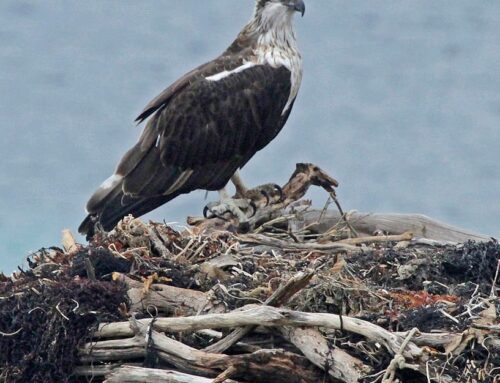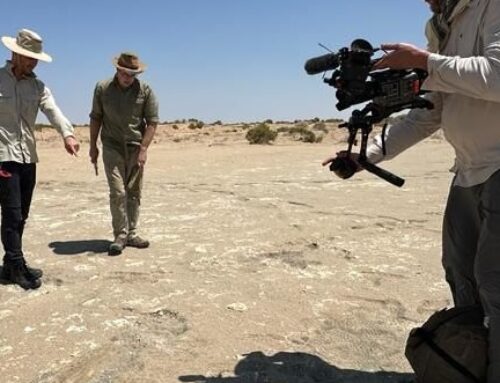In short:
Researchers mapped out a ‘genetic map’, or genome, of the greater bilby, which is a threatened species.
The genome reveals secrets of the bilby’s evolutionary and population history while giving hope for its conservation future.
What’s next?
Having the bilby genome opens up a plethora of research avenues from understanding their biological adaptations, to breeding management.
A new ‘genetic map’ breaking down the entire greater bilby (Macrotis lagotis) genome will help stave off extinction for remaining wild populations susceptible to inbreeding.
Bilbies were once so abundant in Australia that when colonists arrived their presence in the landscape was compared to the prevalence of rabbits in Europe.
Today, it is listed as vulnerable at a national level and is extinct in the wild in some areas.
In the few wild places the last remaining species of bilby is found, it can be difficult to find a trace of them outside of tracks and poop because of the animal’s shy and nocturnal nature.
And that’s a problem when trying to keep the greater bilby out of the history books, as it means no-one really has a good idea of how many are left.
The new genome, which is described today in Nature Ecology and Evolution, not only teases out some of the unique characteristics of this iconic animal, it has contributed to the development of a sophisticated poo analysis tool that can help with its conservation.
University of Sydney population biologist Carolyn Hogg led the international project which involved 35 authors, including desert rangers from the Kiwirrkurra community in Western Australia.
To create the genetic map the researchers needed a freshly deceased bilby.
Roadkill would not do as DNA starts to degrade in living creatures as soon as they die.
Instead the scientists coordinated with a zoo to take samples straight after a bilby, at the end of its natural life, was euthanised.
The reference genome was then compared to the DNA present in scats gathered by Kiwirrkurra people around the Gibson Desert to fine-tune a new poo analysis tool.
As a result, Professor Hogg said scientists could tell families and individual bilbies apart, sex ratios and gene flow between wild populations.
And that’s important, she said, because land managers would be able to track any inbreeding, which can be a precursor to population collapse.
“We can work with the communities to know if feral cat management and traditional burning is improving the bilby population because they can see changes in the genetic diversity,” Professor Hogg said.
Members of the Kiwirrkurra community, which refer to the bilby by several names including ninu, will use information from the genetic information gained from the scats to monitor how land management can influence genetic diversity.
Kiwirrkurra Indigenous Protected Area ranger Scott West said combining the old ways of his people with modern technology was the best way to look after bilbies going forward.
Professor Hogg hopes with more funding other remote communities could become involved in remaining bilby habitat to get a true picture of how many are still out there.
“The problem with wild populations now, like all threatened species, is fragmented populations that are far apart,” she said.
“Before you can make a decision on wild populations you need to know what you have.
“If we can get samples from 20 to 30 individuals in different areas, the hope is we’ll have a better idea.”
The development of modern Australia, the trapping of bilbies and the rapid spread of feral rabbits, foxes and cats led to the extinction of the yallara, or lesser bilby.
Greater bilbies were once found across 70 per cent of mainland Australia but today that figure has dropped to 15 per cent.
They were extinct in New South Wales by 1912, South Australia in the 1930s, the south west of Western Australia in the 1940s and most of Queensland by the 1970s.
But the genome will help inform breeding within the re-established fenced and island populations of bilbies and maintain strong lineages, according to researchers.
Some of the genetic scat sampling revealed increased levels of inbreeding in parts of the Pilbara, one of the two regions in Western Australia that represent the biggest remaining wild populations of the species.
But because of the boom-bust habits of the bilby, with females able to reproduce every three months, the species has the capability to bounce back if feral predators and other factors can be managed.
What else can a bilby’s genes tell us?
Humans have about 19,900 protein-coding genes, a koala has 29,000 but a greater bilby has 38,756.
Unsurprisingly the greater bilby has a lot of genes related to its low metabolic rate as a marsupial that doesn’t drink water, but satiates its H2O requirements through what it eats.
Out of 10 other Australian mammals to have their genomes mapped the bilby also has the highest number of genes related to its olfactory system, which is why it has such a great sense of smell.
DNA Zoo Australia director and University of Western Australia biotechnologist Parwinder Kaur, who was not involved in the study, said the bilby genome was not just a breakthrough for conservation strategies, but provided new avenues of genetic research.
“The sequenced genome reveals interesting past population fluctuations of bilbies, providing insights into historical genetic diversity and environmental impacts,” Dr Kaur said.
The new study estimates that multiple bilby species branched off in the marsupial family, which arrived in Australia 55 million years ago, from northern brown bandicoots some 29 million years ago, which is four million years earlier than our oldest fossil.
And according to the new study, greater bilbies went through a major population decline between 500,000 to 8 million years ago with a similar change to yallara numbers 300,000 to 4 million years ago.
The greater bilby bounced back between 100,000 to 500,000 years ago before declining again.
La Trobe University evolutionary geneticist Jenny Graves, a co-author on the genome study, said future research would also tease out the unique chromosome behaviour of the bilby.
In humans the sex chromosomes (the packages of genes which combine to create individuals) are combinations of x and y chromosomes for males and x and x for females, but the same cannot be said for bilbies.
“What happens is that one of the (bilby) sex chromosomes fuses with another sex chromosome and that creates mayhem,” Professor Graves said.
For male bilbies this means there’s an extra large x chromosome that fuses with a y chromosome and there’s an extra y.
Professor Graves said studying the chromosomes would provide more insight into how genes switch on and off in animals.
“Marsupials can you tell you a lot that we can’t get from mice and humans,” she said.
Get all the latest science stories from across the ABC.



